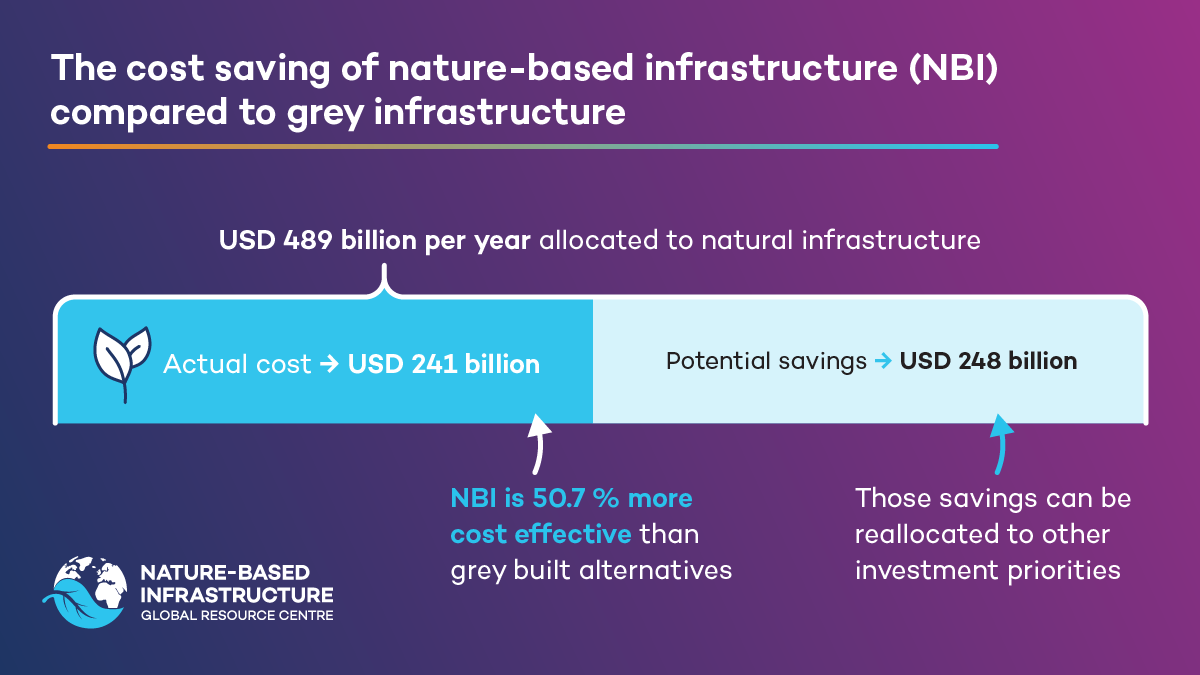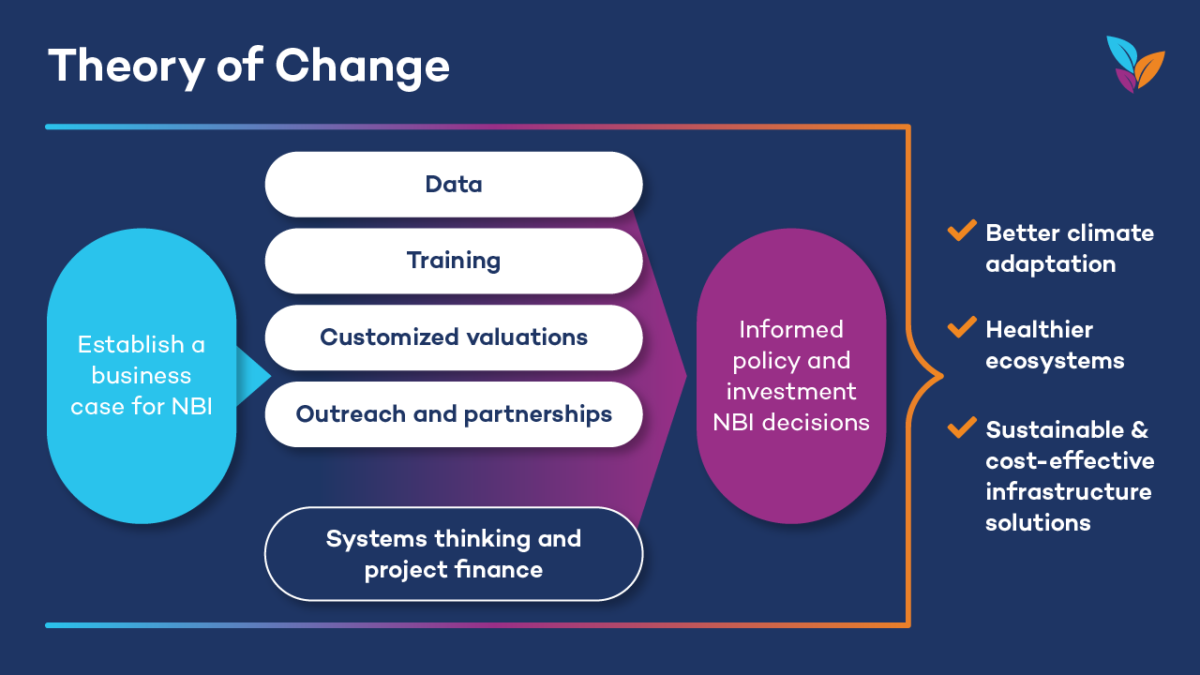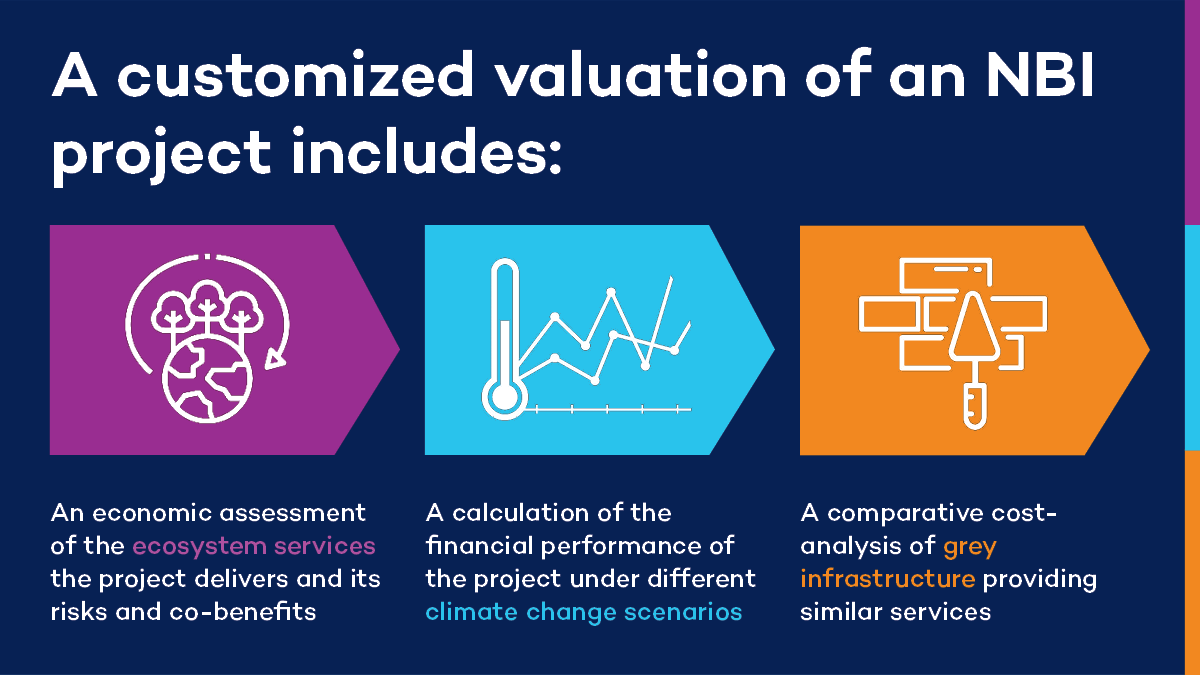Nature-based infrastructure (NBI) lies at the heart of climate change action. It underpins the implementation of the UN Sustainable Development Goals, the Paris Climate Accord and the new international commitments on nature and biodiversity. Despite its wide-ranging benefits, nature-based infrastructure is not being scaled up enough to fulfill its potential. This is because our knowledge of the performance, predictability, and financial viability of nature-based infrastructure has—until now—been limited.
Together with the Global Environment Facility (GEF), the MAVA Foundation, and the United Nations Industrial Development Organization (UNIDO), IISD established the Nature-based Infrastructure Global Resource Centre.
The NBI Global Resource Centre aims to bring together key partners to establish a business case for nature-based infrastructure. We will provide data, training, and sector-specific valuations based on the latest innovations in systems thinking and financial modelling.
We work together with infrastructure planners, policy-makers, decision-makers and financiers to improve the track record of NBI to deliver infrastructure services and adapt to climate change while delivering other environmental, social, and economic benefits.
Find out more: Nature-Based Infrastructure Global Resource Centre (iisd.org)
Check out our latest NBI report: How Can Investment in Nature Close the Infrastructure Gap? Nature-Based Infrastructure Global Resource Centre How Can Investment in Nature Close the Infrastructure Gap? (iisd.org)

Our approach
The complexity of NBI requires taking a systemic approach when we plan, value, and implement infrastructure projects. It also requires knowledge integration and collaboration with partners in the field.
Our work quantifies the positive impact of stewardship activities on ecosystems and demonstrates the cost efficiency of nature-based infrastructure.

Objectives
The NBI Global Resource Centre seeks to:
- Improve the predictability and certainty of performance of NBI through more than 40 customized valuations of NBI projects globally.
- Provide access to the data on the NBI performance through a new online database
- Strengthen the capacity of key stakeholders to understand and value NBI through a Massive Open Online Course and customized training
- Connect and build partnerships through the NBI Global Resource Centre
If you are interested in submitting proposals for assessments and collaborate with us to develop customized valuations of your projects, contact us.
We offer valuations that include:
- The creation of a qualitative assessment of the impacts of the NBI project
- An economic assessment of the ecosystem services delivered by a given project
- A financial assessment of the performance of the project under different climate change scenarios, with climate data derived from the EU’s Copernicus Climate Data Store.
- A comparison with the cost of grey-built infrastructure that provides the same level of services

Examples of NBI valuations
Green roofs and urban trees, South Africa
This WWF’s report makes the case for the inclusion of nature-based infrastructure at Rainbow Junction, a new greenfields development situated in Tshwane, using the SAVi tool to address future climate impacts. The cost-benefit analysis conducted was informed by multipliers from the international literature to assess the impacts of green roofs and urban trees and value carbon storage, energy reduction and stormwater retention benefits.
Pelly’s Lake, Canada
Pelly’s Lake is a natural lake and wetland in Pembina Valley in Manitoba (Canada). Stephenfield Reservoir was built in 1963 for the storage of water for irrigation and domestic water supply. Our SAVi assessment showed that Stephenfield Reservoir is a very cost-effective solution for storing water and enabling irrigation.
Lake Dal, India
In this SAVi assessment, we analyzed long-term conservation measures for Lake Dal, a major natural asset of India in the State of Jammu and Kashmir. Untreated domestic sewage and encroachment from informal dwellings have a severe negative impact on the lake’s water quality, fishery, and local tourism. The SAVi assessment evaluated an upgrade of the sewage treatment plants in combination with the construction of an artificial wetland.
Saloum Delta, Senegal
The Saloum Delta in Senegal is a tropical mangrove ecosystem that supports the livelihoods of more than 100,000 people, for instance by filtering water, providing fuel wood, and supporting fish stocks. Climate change and the unsustainable use of mangroves put pressure on the services the Delta delivers. Based on our SAVi assessment, the ecosystem services of the Saloum Delta are worth CFA 3,589 billion (EUR 5.47 billion) over 40 years.
Wetlands, Italy
The wetlands S’Ena Arrubia and Corru S’Ittiri-Marceddì-San Giovanni in Sardinia, Italy, support local tourism, agriculture, and aquaculture. However, climate change and human influences burden the ecosystems. Under the current trend of degradation, the wetlands generate ecosystem services worth EUR 306 million over 40 years. Our SAVi assessment showed that protecting the wetlands can allow for an additional EUR 171 million in services. Furthermore, reusing local livestock manure for biogas and organic fertilizer production offers a net benefit to the community.
Agroforestry, Belgium
The municipality of Welkenraedt in Belgium plans to use agroforestry to adapt to climate change. Growing trees and hedges on farmland provides multiple benefits, such as increased agricultural yields, biomass production, and reduced heat stress on livestock. Based on our SAVi assessment, the agroforestry project in Welkenraedt brings a net benefit of EUR 3.9 million over 20 years. Planting and maintaining the 100,000 m² of trees and hedges costs about EUR 600,000.
Stormwater, Johannesburg
The city of Johannesburg in South Africa faces severe climate risks. To avoid further damages from flash flooding, the city upgraded the stormwater infrastructure in the Paterson Park Precinct. The chosen hybrid solution combines a concrete culvert with a renaturalized stream section. Our SAVi assessment showed that this hybrid infrastructure provides a higher return on investment than grey solutions.